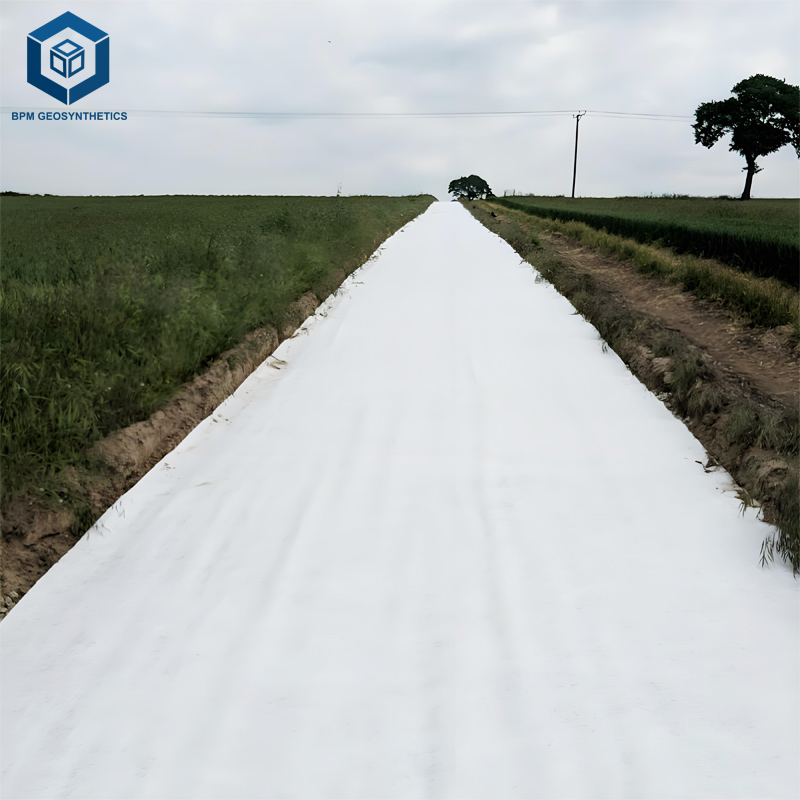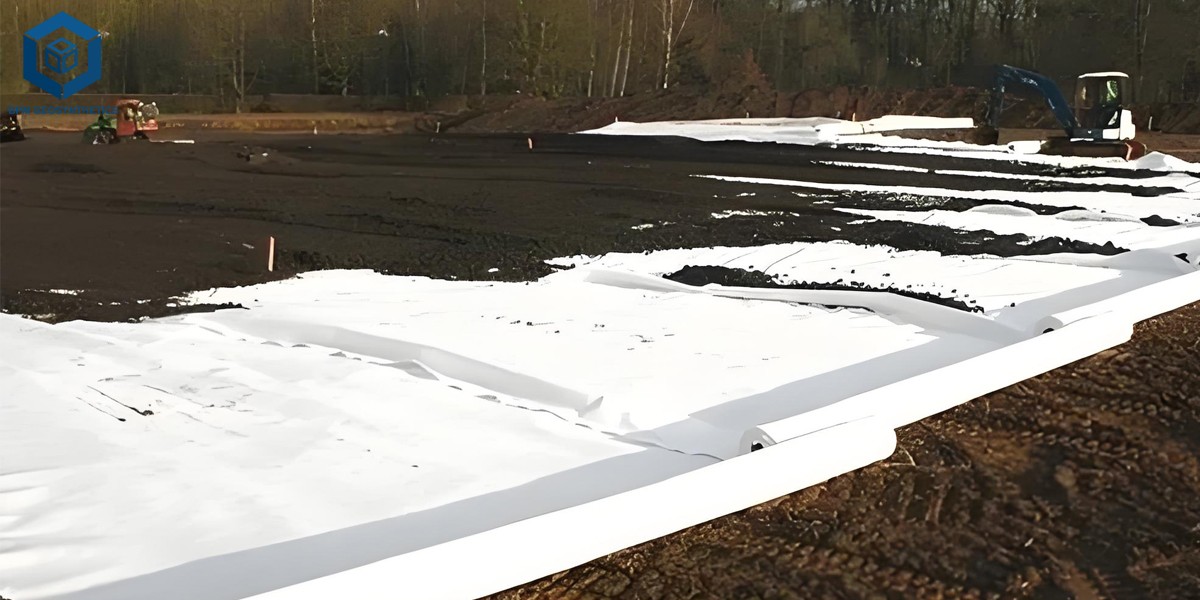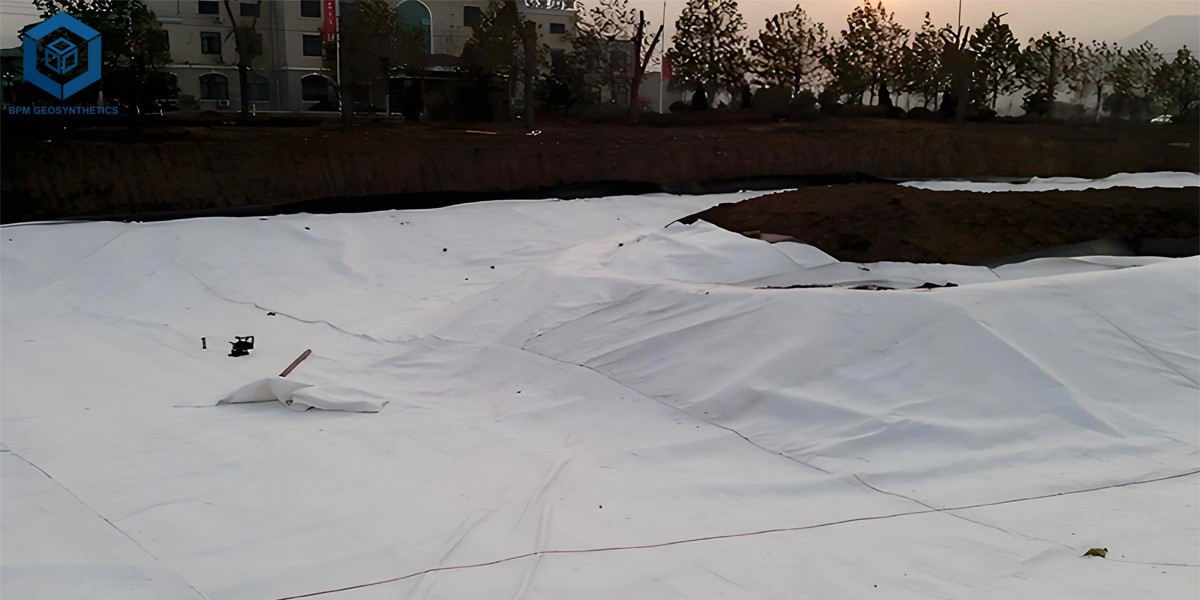Geotextile 180g m2
Geotextile 180g m2 is a versatile and lengthy lasting synthetic material used in a variety civil engineering and improvement applications. This non-woven geotextile is designed to furnish separation, filtration, and reinforcement for soil and combination layers. Its amazing drainage normal overall performance helps end soil erosion and beautify structural stability.
- High strength
The weight of 180g/m ² affords considerable tensile strength, making it appropriate for load-bearing applications.
- Effective filtering
This geotextile permits water to pass by thru whilst keeping soil particles, stopping clogging and soil erosion.
- Durability
Resistant to ultraviolet radiation, chemicals, and biodegradation, making sure a lengthy provider lifestyles beneath a number environmental conditions.
Geotextile 180g m2 is a high-strength, non woven geosynthetic fabric made from one hundred percent polypropylene or polyester fibers via superior needle punching or thermal bonding processes. Designed to supply ideal filtration, drainage, and soil stabilization performance, this geotextile is an vital fabric in present day civil, environmental, and hydraulic engineering projects.
Manufactured with the aid of BPM Geosynthetics, one of China’s main geosynthetic producers and exporters, the 180g/m² geotextile combines durability, flexibility, and value effectivity for long-term engineering performance.
1. What is Geotextile 180g m2?
Geotextile 180g/m² refers to a non woven geotextile material with a unit weight of 180 grams per rectangular meter. It is made of artificial fibers robotically interlocked to structure a strong and permeable fabric. The non woven geotextile landscape fabric permits water to pass by via whilst stopping soil particle migration, imparting extremely good filtration and separation functions.
Depending on assignment needs, BPM Geotextile can supply:
- Non Woven Geotextile Fabric (Needle-punched or heat-bonded)
- Woven Geotextile Fabric (High tensile electricity and stability)
This medium-weight geotextile is best for subgrade stabilization, drainage systems, and erosion control, imparting dependable overall performance throughout a large vary of soil conditions.
2. Technical Specifications of Geotextile 180g/m²
| Property | Test Method | Typical Value |
Material | 100% Polypropylene (PP) or Polyester (PET) | — |
Mass per Unit Area | ASTM D5261 | 180 g/m² |
Thickness | ASTM D5199 | 1.2 – 1.5 mm |
Tensile Strength (MD/CD) | ASTM D4595 | ≥ 8.5 / 7.0 kN/m |
Elongation at Break | ASTM D4595 | 50 – 80% |
Permeability Coefficient | ASTM D4491 | ≥ 1.0 × 10⁻² cm/s |
Puncture Resistance | ASTM D4833 | ≥ 400 N |
UV Resistance | ASTM D4355 | ≥ 70% Strength Retained after 500h Exposure |
Note: Custom specifications and roll sizes are available upon request.
3. Key Functions of Geotextile 180g m2
3.1 Separation
The 180g/m² geotextile road fabric successfully prevents the intermixing of distinctive soil layers, making sure that the structural integrity and layout electricity of subgrades, roadbeds, and drainage structures are maintained over time. By developing a steady interface between fine-grained and coarse-grained materials, it minimizes illness and preserves the load-bearing potential of the foundation. This characteristic is imperative in avenue construction, railway foundations, and landfill caps, the place soil layer balance without delay impacts overall performance and longevity.
3.2 Filtration
This nonwoven geotextile permits water to ignore via freely whilst protecting pleasant soil particles, stopping the clogging or silting of drainage and filtration systems. Its steady pore dimension distribution ensures long-term filtration overall performance beneath variable hydraulic conditions. The 180g/m² geo cloth gives top notch permeability, making it best for purposes such as subsurface drainage systems, maintaining wall backfills, and coastal engineering tasks the place non-stop water drift and soil retention are critical.
3.3 Drainage
The non woven filter fabric acts as an environment friendly drainage path, channeling extra water away from soil buildings and lowering pore water strain buildup. Its excessive water waft ability enhances the typical steadiness of roadbeds, embankments, and conserving structures, supporting to forestall erosion, sliding, or basis failure. Whether hooked up in the back of protecting partitions or below pavement systems, BPM’s 180g/m² Geotextile ensures dependable hydraulic overall performance and long-term sturdiness even below heavy load and fluctuating moisture conditions.
3.4 Reinforcement
With excessive tensile power and low elongation, the 180g/m² geotextile fabric presents most fulfilling soil reinforcement via distributing masses evenly and stopping deformation. It will increase the standard steadiness of susceptible soil foundations and reduces contract or rutting in avenue and railway construction. The non woven geotextile’s mechanical homes allow it to feature as a reinforcing aspect in embankments, slopes, and maintaining walls, substantially extending the carrier existence of infrastructure tasks whilst decreasing renovation costs.
3.5 Protection
The non woven landscape fabric serves as a defensive cushioning layer that safeguards geomembranes, water-resistant liners, and different geosynthetic substances from puncture, abrasion, or mechanical affect throughout set up or operational phases. It correctly absorbs and distributes stresses precipitated via stones, sharp objects, or gear loads, making sure the long-term integrity of the underlying waterproofing system. BPM’s 180g/m² geo fabric is extensively used in landfill lining systems, ponds, and reservoirs, offering an delivered layer of reliability and safety.
4. Advantages of BPM Geotextile 180g m2
4.1 Superior Material Quality
BPM Geotextiles are made from high-quality, UV-stabilized polypropylene or polyester fibers with gorgeous resistance to chemical, biological, and environmental degradation. The film geotextile continues steadiness in acidic, alkaline, and saline conditions.
4.2 Advanced Manufacturing Technology
Produced the usage of superior needle punching and warmness bonding technology, BPM’s geotextile fabric under gravel characteristic uniform thickness, steady strength, and amazing filtration precision.
4.3 Customization and Flexible Options
BPM affords geotextile filter fabric from 100g/m² to 1200g/m², with a range of roll widths and lengths to meet particular engineering needs. Woven and non woven sorts are accessible upon request.
4.4 Easy Installation and Handling
Lightweight but durable, BPM Geotextile 180g/m² is convenient to transport, cut, and installation on-site. It conforms nicely to irregular surfaces, decreasing labor time and set up costs.
4.5 Environmental Safety
Manufactured from non-toxic, inert substances that do now not launch damaging components into the environment, making sure compliance with environmental safety standards.
4.6 Reliable Factory and Global Supply
As a main geosynthetic producer in China, BPM Geosynthetics has over 20 years of manufacturing experience, exporting to extra than 100 countries.
BPM Geosynthetics Ensures:
- ISO9001, ISO14001, and CE certifications
- Strict first-class manipulate in each and every manufacturing stage
- Global logistics guide and technical guidance
- Competitive factory-direct pricing
5. Applications of Geotextile 180g m2
5.1 Geotextile 180g m2 for Road and Railway Construction
Nonwoven geotextile fabric 180g/m² is extensively used as a separation and stabilization layer below roads, highways, and railway tracks. By stopping the intermixing of subgrade soils with aggregates, it preserves the integrity and energy of the pavement structure. This reduces settlement, rutting, and deformation beneath repeated visitors loads, correctly extending the carrier existence of transportation infrastructure. Its excessive tensile power and flexibility permit it to conform to uneven surfaces, making it suitable for each new building and upkeep projects.
5.2 Geotextile 180g m2 for Drainage Systems
The non woven geotextile drainage fabric features as an environment friendly filtration and drainage layer in subsurface drainage systems, French drains, conserving walls, and embankments. It approves water to omit via whilst holding soil particles, stopping clogging of drainage pipes and channels. This ensures secure water flow, reduces hydrostatic strain in the back of walls, and minimizes soil erosion. Its sturdiness and permeability make it best for each brief and long-term drainage applications.
5.3 Geotextile 180g m2 for Landfill Engineering
In landfill applications, non woven geotextile membrane 180g/m² is generally used above geomembranes as a protecting and filtration layer. It prevents puncture or harm induced through sharp waste substances and ensures the integrity of the underlying liner. Additionally, the cloth presents filtration to stop soil migration into drainage layers, keeping regular leachate administration and decreasing environmental risks. This makes it an critical issue in landfill caps, backside liners, and containment systems.
5.4 Geotextile 180g m2 for Riverbanks, Canals, and Dams
Geotextile drainage fabric 180g/m² offers superb erosion manipulate and filtration for hydraulic structures, which includes riverbanks, canals, and dams. It stabilizes soil, reduces scouring, and prevents sediment displacement underneath water waft or wave action. By setting apart soil layers and retaining drainage paths, it enhances the toughness and overall performance of hydraulic engineering works, making it appropriate for each small-scale tasks and large-scale infrastructure.
5.5 Geotextile 180g m2 for Landscaping and Agriculture
In landscaping and agricultural projects, the geotextile landscape fabric is used for backyard drainage, inexperienced roofs, irrigation channels, and soil separation. It ensures suited water administration whilst stopping soil mixing, promotion healthful plant boom and retaining structural stability. Its lightweight, bendy nature permits handy set up on slopes, terraces, and rooftop gardens, making it a versatile answer for city and rural water administration systems.
5.6 Geotextile 180g m2 for Tunnel and Retaining Wall Waterproofing
Non woven geotextile fabric 180g/m² is utilized as a defensive and drainage layer at the back of holding walls, tunnel linings, and water-proof membranes. It prevents mechanical harm from rocks, debris, or development tools whilst retaining drainage efficiency. By facilitating water float away from quintessential structures, it reduces hydrostatic pressure, minimizes water accumulation, and enhances the sturdiness and protection of underground and maintaining structures.
6. Geotextile 180g m2 Installation Guidelines
6.1 Site Preparation
Before putting in geo textile material 180g/m², it is imperative to proper put together the web page to make certain best performance. The floor ought to be absolutely cleaned and leveled, doing away with all sharp stones, debris, tree roots, and different limitations that ought to puncture or harm the geotextile. Any uneven areas, holes, or smooth spots ought to be compacted or crammed to create a steady foundation. Proper web page guidance now not solely protects the driveway fabric stabilization geotextile fabric however additionally enhances its filtration, separation, and reinforcement functions.
6.2 Placement
Carefully unroll the geo tech fabric over the organized surface, making sure that it lies flat and free of wrinkles, folds, or anxiety points. Smooth placement is imperative to hold uniform insurance and forestall localized stress or gaps that may want to compromise the geotextile’s functionality. For giant areas, it is endorsed to work systematically, unrolling and positioning one area at a time whilst preserving alignment with undertaking specifications.
6.3 Overlap
When laying more than one rolls of non woven geotextile filter fabric, make sure ample overlap, normally 20–30 cm, or as certain in the mission design. Overlapping ensures non-stop coverage, prevents soil intrusion between adjoining sheets, and continues the integrity of filtration, separation, and drainage functions. In areas with excessive hydraulic stress or heavy load, large overlaps might also be required to assurance long-term stability.
6.4 Anchoring
To forestall the non woven geotextile fabric double punched from transferring in the course of placement or backfilling, quickly anchor it the usage of nails, stakes, sandbags, or small soil covers. Proper anchoring ensures the geotextile stabilization fabric stays in role throughout set up and minimizes the chance of motion brought about by using wind, water flow, or building activities. This step is especially necessary on slopes, embankments, and different areas inclined to displacement.
6.5 Backfill or Cover
Once the geotextile fabric under pavers is successfully placed and anchored, observe aggregate, soil, or different shielding cowl layers evenly throughout its surface. This protects the driveway stabilization fabric from mechanical damage, UV exposure, and environmental stress whilst making sure suitable load distribution. The backfill or cowl layer must be utilized steadily and compacted if necessary, taking care to keep away from sharp equipment or heavy gear that can also puncture or tear the non woven needle punched geotextile. Proper insurance ensures long-term overall performance in filtration, drainage, reinforcement, and protecting applications.
Conclusion
Geotextile 180g m2 with the aid of The Best Project Material Co., Ltd.(BPM Geosynthetics)is a versatile, durable, and eco-friendly cloth that enhances soil stability, drainage, and safety throughout a couple of engineering fields. With BPM Geosynthetics’s superior manufacturing, strict pleasant control, and expert technical support, this geotextile ensures wonderful long-term overall performance for infrastructure, environmental, and hydraulic initiatives worldwide.











